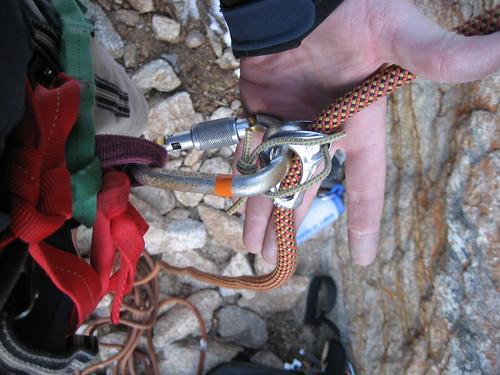Recently, I have been trying out a somewhat new climbing technique called Solo Top Roping. This essentially allows me to go out on my own and safely climb some routes. This is differnet that my usual "style" of climbing because I do not have a partner with me. Anyhow, I close friend of mine does this quite a bit so he was able to get me going on it. However, when searching my usual climbing resources, I found it difficult to find any information so I decided to post my method.
Standard disclaimer: this is a somewhat advanced technique. If you are not comfortable with jugging, rappelling, and transitioning between the two, you should probably get those down first. Also, remember that you are on your own so if you forget something in your pack, you may be stuck!
Step one is to get to the top of a route and rig up a bomber anchor. The usual rules apply (redundant, equalized, non-extending, etc). Here you can see my 3 bolt anchor with a cordalette. Then you attach your rope with a figure 8 and a couple biners. I typically use at least one locker. Also, pad any edges the rope will pass over. This is important because the rope is not moving so the same spot will rub on the rock as you weight and unweight the rope.

Depending on the route, you may want to rap the route and clip the draws. This is nice if the route wanders or is overhanging. Here is what it looks like from the bottom.

Now you can start rigging yourself up. First make sure you have everything you need because it is a pain to get more stuff after you are hooked up. I attach my backup first. I use a Tiblock clipped straight into my belay loop. NOTE! It should be pointed out that I rigged my Tiblock backwards! Yikes! The rope should be on the inside of the biner.

Next, I add a Mini-Traxion above the Tibloc, again clipped directly to my belay loop.

Then I make a chest harness from a double sling and tie the Mini-T to it. This keeps the Mini-T high, reducing the distance of the fall to almost nothing. This also keeps the locker from being accidently crossloaded.

Finally I add some wight to the rope by tying a water bottle or my pack to the bottom of the rope. So, as I climb up, the rope slips through both the Mini-T and the Tibloc but if I fall or need to take a break, the Mini-T clamps onto the rope. In other words, both of them will easily slide up the rope but not down the rope.
Critiques of the system:
Some people are skeptical of self belay with a Mini-T because of teeth on the cam. There is talk of it shearing off the sheath of the rope if you take a whipper on it. If I were using this to solo lead climb, I may find that to be concerning but I only use this on a TR setup that is slabby to slightly overhanging. The falls I take are never substantial and I would not use this on anything that could possible generate anything close to a whipper. My falls are usually in the 2-3" range, which is mostly from rope stretch after the Mini-T has engaged.
I do slightly worry about cross loading my backup Tibloc and next time I see one of those lockers with the plastic crossbar, I will snag it. However, even if my Mini-T fails and I do end up on my backup, the fall will be small (maybe 6 inches). That being said, I do keep an close eye on it when I am climbing.

4 comments:
Once you get to the top of the route, how do you go about disengaging the mini-traxion and tibloc and then rapping back to the ground?
If I made it to the top of the route, I usually clip myself directly to the anchors, replace the Tibloc with a GriGir, get my weight off the Mini-T, and then remove it completely. If I am in the middle of the route, I do the same thing but use a couple jumars above the Mini T instead of clipping to the anchors. This is definitely something to practice near the ground and with people around.
Does the tibloc not trash your ropes?
^ only if the mini-t fails and he takes a fall on it.
Post a Comment